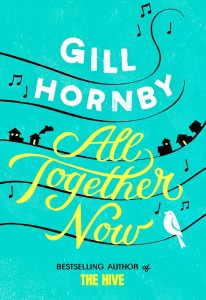 Published by Little Brown UK/US
Published by Little Brown UK/US
336pp, hardcover, £14.99/$26
Reviewed by Zoë Fairbairns
‘A singer is one singer; singers are many singers; a group of singers is just what it sounds like. A choir though – a living, breathing, working choir – is something else entirely. It is the singular product of physical reactions that can only come into being under certain laboratory conditions. And no scientist alive can tell you exactly what they are.’
Well maybe – but whose view is this? A fondness for bland, unattributed, middle-distance editorializing is one of the less comfortable aspects of Gill Hornby’s novel of choral life in an English village, All Together Now. Far more acute are the parts where the book sets aside the philosophizing and generalized observations, and concentrates on the singers as individuals.
Annie Miller is a middle-aged empty-nester who seems always to be seeing people off on trains but never going anywhere herself. Alone in her house, she strikes up conversations with unknown Indian call centre workers who only rang to find out if she was happy with her broadband provider. She’s a mainstay of the Monday After-Lunch Pre School Storytime at the library, but even that is running out of customers. She turns to the choir to give  meaning to her life.
meaning to her life.
Other members of the choir include Jazzy, a troubled teenage waitress with a here-today-gone-tomorrow mother, as well as a here-today-gone-tomorrow pregnancy of her own. There’s Tracey who has a secret past as an unsuccessful contestant in the Eurovision Song Contest, and two teenage boys called Curly and Squat who, superficially as unappealing as their nicknames, nevertheless have good voices. Then there is Bennett, an unemployed actuary who is grieving for his lost job, lost marriage, and lost God: ‘Twenty-five years ago…God was part lord, part father, with a background in the military. Now, it seemed, He had been rather sidelined for Jesus who had grown up into quite a different sort of chap (who) seemed to make everyone in the congregation very jittery and over-excited.’ Forced to admit to himself that the church is no longer ‘his gang’, Bennett joins the choir, even though secretly he would rather be singing a Latin Gloria than Simon & Garfunkel medleys or protest songs about plans to lay waste parts of the village to accommodate a new superstore.
The problem with novels that lean for their content on fictional works of art (paintings, sculptures, music, other books) is that because as reader you can’t see or hear what is being written about, it’s hard to have an attitude to it. Statements from the uninvolved, unidentified, sometimes-omniscient-sometimes-not narrator of All Together Now about the quality of the singing can hardly be relied on. The upcoming county championship may provide some indication of whether the Bridgeford choir is any good.
Before that, though, there is an exquisite moment of the choir excelling itself. Conducting a rehearsal that seems to be going particularly well, Tracey lowers her baton and discreetly signals to the pianist to stop playing. The singing continues, unaccompanied, unsupported, unled: ‘To Tracey’s delight and their own wonder they were flying. Like skydivers in formation they were all together; airborne. And the rest of the world felt very far away.’
After that, the result of the county championships (which I shall not reveal) seems neither here nor there.
